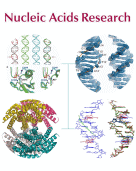-
PDF
- Split View
-
Views
-
Cite
Cite
Scott E. Devine, Jef D. Boeke, Efficient integration of artificial transposons into plasmid targets in vitro: a useful tool for DNA mapping, sequencing and genetic analysis, Nucleic Acids Research, Volume 22, Issue 18, 11 September 1994, Pages 3765–3772, https://doi.org/10.1093/nar/22.18.3765
Close - Share Icon Share
Abstract
We have developed efficient methods for creating artificial transposons and inserting these transposons into plasmid targets in vitro, primarily for the purpose of DNA mapping and sequencing. A novel plasmid has been engineered to convert virtually any DNA sequence, or combination of sequences, into an artificial transposon; hence, custom transposons containing any desired feature can be easily designed and constructed. Such transposons are then efficiently inserted into plasmid targets, in vitro, using the integrase activity present in yeast Ty1 virus-like particles. A single in vitro integration reaction, which resembles a simple restriction digestion in the complexity of the reaction, gives rise to thousands of recoverable insertion events within DNA target molecules; this frequency approaches one insertion per phosphodiester bond in typical plasmids. Importantly, transposon insertions are recovered from all regions of DNA inserts carried on plasmid targets, indicating that integration is a random or nearly-random process. Because of its versatility, this technology offers a generalized method of generating recombinant DNA molecules of a desired structure. We have adapted this system for DNA sequencing by developing a customized artificial transposon to insert new primer binding sites into internal regions of DNA inserts carried on cloning vectors. Transposon insertions have been generated throughout several different yeast and human DNA inserts carried on plasmids, allowing the efficient recovery of sequence information from these inserts. Our results demonstrate the overall utility of this method for both small and large-scale DNA sequencing, as well as general DNA restructuring, and indicate that it could be adapted for use with a number of additional applications including functional genetic analysis.




Comments